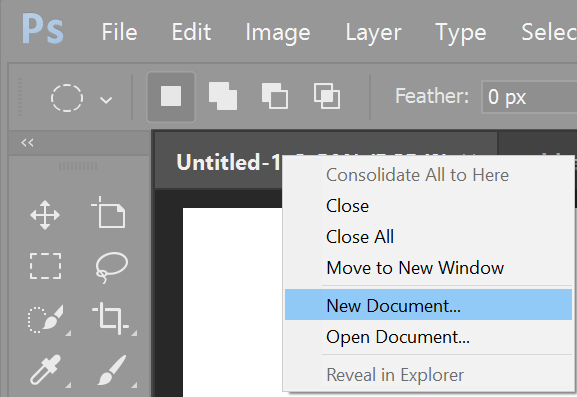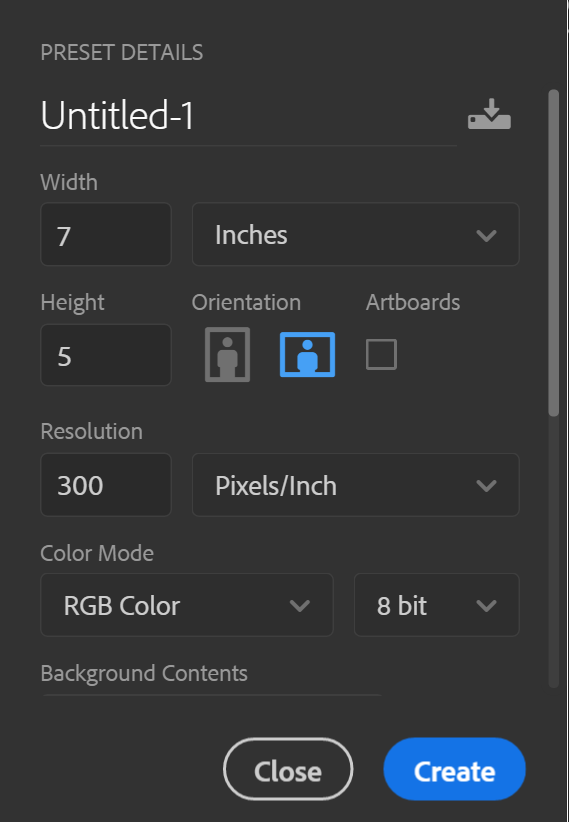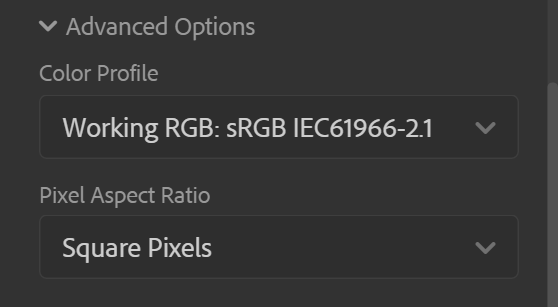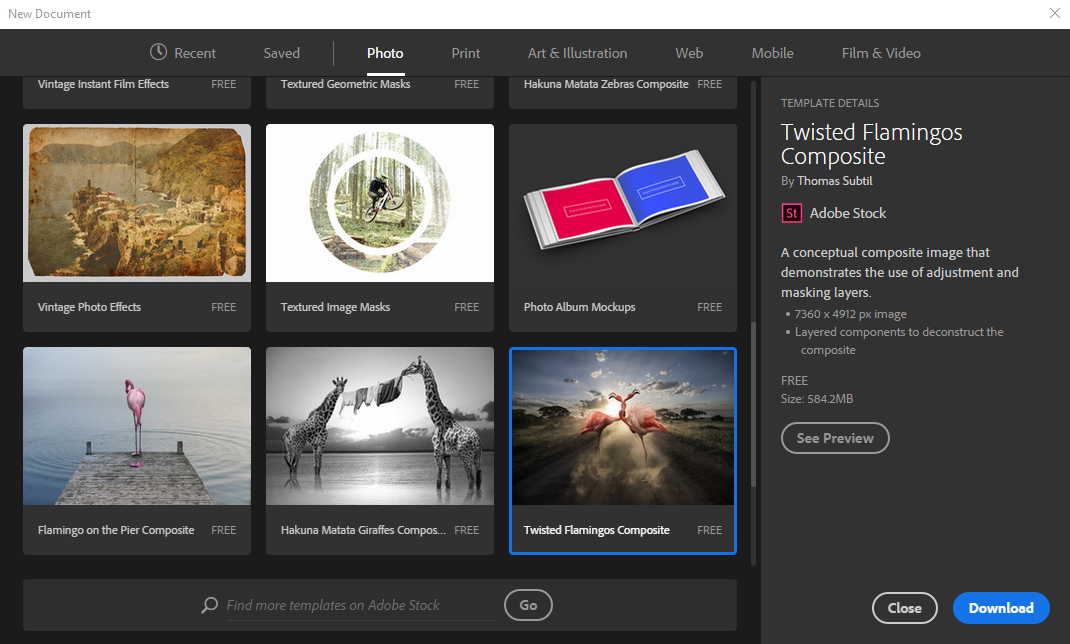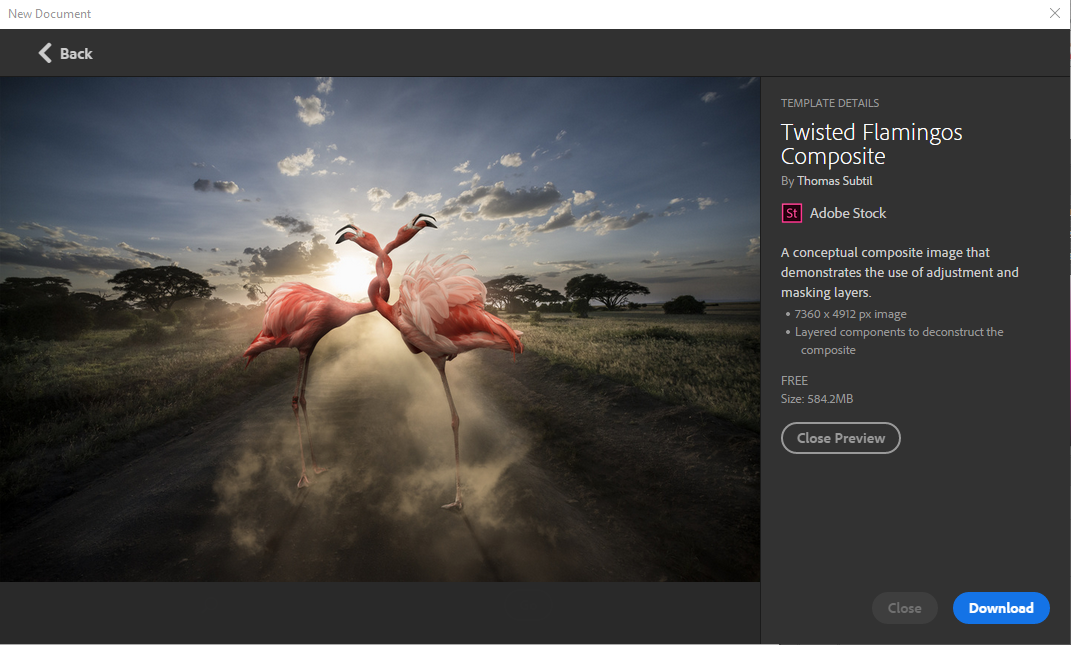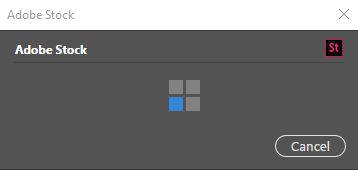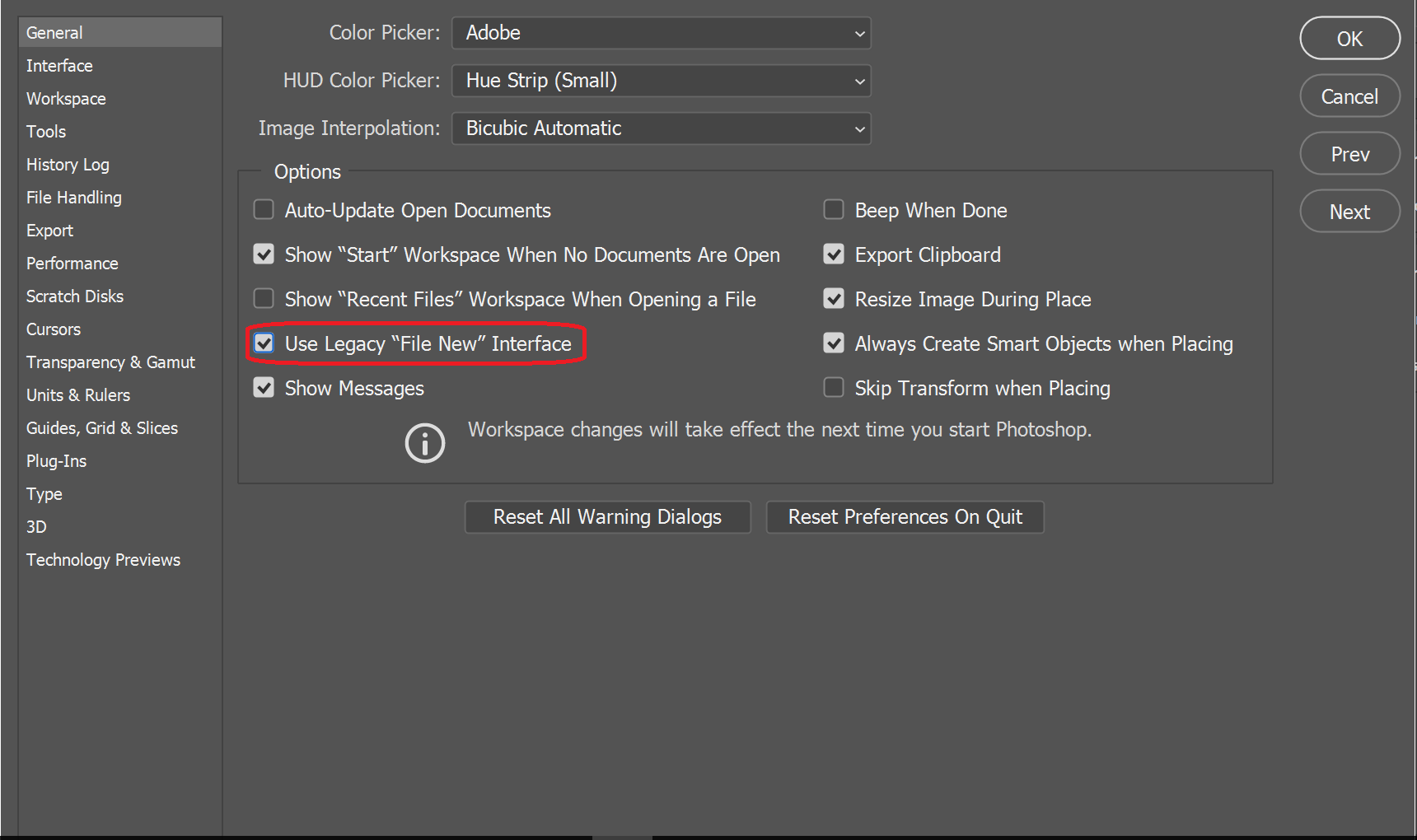- Photoshop User Guide
- Introduction to Photoshop
- Photoshop and other Adobe products and services
- Photoshop on mobile (not available in mainland China)
- Photoshop on the iPad (not available in mainland China)
- Photoshop on the iPad | Common questions
- Get to know the workspace
- System requirements | Photoshop on the iPad
- Create, open, and export documents
- Add photos
- Work with layers
- Draw and paint with brushes
- Make selections and add masks
- Retouch your composites
- Work with adjustment layers
- Adjust the tonality of your composite with Curves
- Apply transform operations
- Crop and rotate your composites
- Rotate, pan, zoom, and reset the canvas
- Work with Type layers
- Work with Photoshop and Lightroom
- Get missing fonts in Photoshop on the iPad
- Japanese Text in Photoshop on the iPad
- Manage app settings
- Touch shortcuts and gestures
- Keyboard shortcuts
- Edit your image size
- Livestream as you create in Photoshop on the iPad
- Correct imperfections with the Healing Brush
- Create brushes in Capture and use them in Photoshop on the iPad
- Work with Camera Raw files
- Create and work with Smart Objects
- Adjust exposure in your images with Dodge and Burn
- Auto adjustment commands in Photoshop on the iPad
- Smudge areas in your images with Photoshop on the iPad
- Saturate or desaturate your images using Sponge tool
- Content aware fill for iPad
- Photoshop on the web (not available in mainland China)
- Photoshop (beta) (not available in mainland China)
- Generative AI (not available in mainland China)
- Common questions on generative AI in Photoshop
- Generative Fill in Photoshop on the desktop
- Generate Image with descriptive text prompts
- Generative Expand in Photoshop on the desktop
- Replace background with Generate background
- Get new variations with Generate Similar
- Select an AI model for generative control
- Generative Fill in Photoshop on the iPad
- Generative Expand in Photoshop on the iPad
- Generative AI features in Photoshop on the web
- Content authenticity (not available in mainland China)
- Cloud documents (not available in mainland China)
- Photoshop cloud documents | Common questions
- Photoshop cloud documents | Workflow questions
- Manage and work with cloud documents in Photoshop
- Upgrade cloud storage for Photoshop
- Unable to create or save a cloud document
- Solve Photoshop cloud document errors
- Collect cloud document sync logs
- Invite others to edit your cloud documents
- Share documents for review
- Workspace
- Workspace basics
- Preferences
- Learn faster with the Photoshop Discover Panel
- Create documents
- Place files
- Default keyboard shortcuts
- Customize keyboard shortcuts
- Tool galleries
- Performance preferences
- Contextual Task Bar
- Use tools
- Presets
- Grid and guides
- Touch gestures
- Use the Touch Bar with Photoshop
- Touch capabilities and customizable workspaces
- Technology previews
- Metadata and notes
- Place Photoshop images in other applications
- Rulers
- Show or hide non-printing Extras
- Specify columns for an image
- Undo and history
- Panels and menus
- Position elements with snapping
- Position with the Ruler tool
- Organize, share, and collaborate with Projects
- Refine Adobe Firefly generations
- Image and color basics
- How to resize images
- Work with raster and vector images
- Image size and resolution
- Acquire images from cameras and scanners
- Create, open, and import images
- View images
- Invalid JPEG Marker error | Opening images
- Viewing multiple images
- Customize color pickers and swatches
- High dynamic range images
- Match colors in your image
- Convert between color modes
- Color modes
- Erase parts of an image
- Blending modes
- Choose colors
- Customize indexed color tables
- Image information
- Distort filters are unavailable
- About color
- Color and monochrome adjustments using channels
- Choose colors in the Color and Swatches panels
- Sample
- Color mode or Image mode
- Color cast
- Add a conditional mode change to an action
- Add swatches from HTML CSS and SVG
- Bit depth and preferences
- Layers
- Layer basics
- Nondestructive editing
- Create and manage layers and groups
- Select, group, and link layers
- Place images into frames
- Layer opacity and blending
- Mask layers
- Apply Smart Filters
- Layer comps
- Move, stack, and lock layers
- Mask layers with vector masks
- Manage layers and groups
- Layer effects and styles
- Edit layer masks
- Extract assets
- Reveal layers with clipping masks
- Generate image assets from layers
- Work with Smart Objects
- Blending modes
- Combine multiple images into a group portrait
- Combine images with Auto-Blend Layers
- Align and distribute layers
- Copy CSS from layers
- Load selections from a layer or layer mask's boundaries
- Knockout to reveal content from other layers
- Selections
- Get started with selections
- Make selections in your composite
- Select and Mask workspace
- Select with the marquee tools
- Select with the lasso tools
- Adjust pixel selections
- Move, copy, and delete selected pixels
- Create a temporary quick mask
- Select a color range in an image
- Convert between paths and selection borders
- Channel basics
- Save selections and alpha channel masks
- Select the image areas in focus
- Duplicate, split, and merge channels
- Channel calculations
- Get started with selections
- Image adjustments
- Replace object colors
- Perspective warp
- Reduce camera shake blurring
- Healing brush examples
- Export color lookup tables
- Adjust image sharpness and blur
- Understand color adjustments
- Apply a Brightness/Contrast adjustment
- Adjust shadow and highlight detail
- Levels adjustment
- Adjust hue and saturation
- Adjust vibrance
- Adjust color saturation in image areas
- Make quick tonal adjustments
- Apply special color effects to images
- Enhance your image with color balance adjustments
- High dynamic range images
- View histograms and pixel values
- Match colors in your image
- Crop and straighten photos
- Convert a color image to black and white
- Adjustment and fill layers
- Curves adjustment
- Blending modes
- Target images for press
- Adjust color and tone with Levels and Curves eyedroppers
- Adjust HDR exposure and toning
- Dodge or burn image areas
- Make selective color adjustments
- Image repair and restoration
- Image enhancement and transformation
- Drawing and painting
- Paint symmetrical patterns
- Draw rectangles and modify stroke options
- About drawing
- Draw and edit shapes
- Create star or any other pointed shape
- Painting tools
- Create and modify brushes
- Blending modes
- Add color to paths
- Edit paths
- Paint with the Mixer Brush
- Brush presets
- Gradients
- Gradient interpolation
- Fill and stroke selections, layers, and paths
- Draw with the Pen tools
- Create patterns
- Generate a pattern using the Pattern Maker
- Manage paths
- Manage pattern libraries and presets
- Draw or paint with a graphics tablet
- Create textured brushes
- Add dynamic elements to brushes
- Gradient
- Paint stylized strokes with the Art History Brush
- Paint with a pattern
- Sync presets on multiple devices
- Migrate presets, actions, and settings
- Text
- Filters and effects
- Saving and exporting
- Color Management
- Web, screen, and app design
- Video and animation
- Printing
- Automation
- Troubleshooting
Jump-start your creative projects with a wide variety of templates from Adobe Stock and blank presets.
Introduced in Adobe Photoshop 2017 release
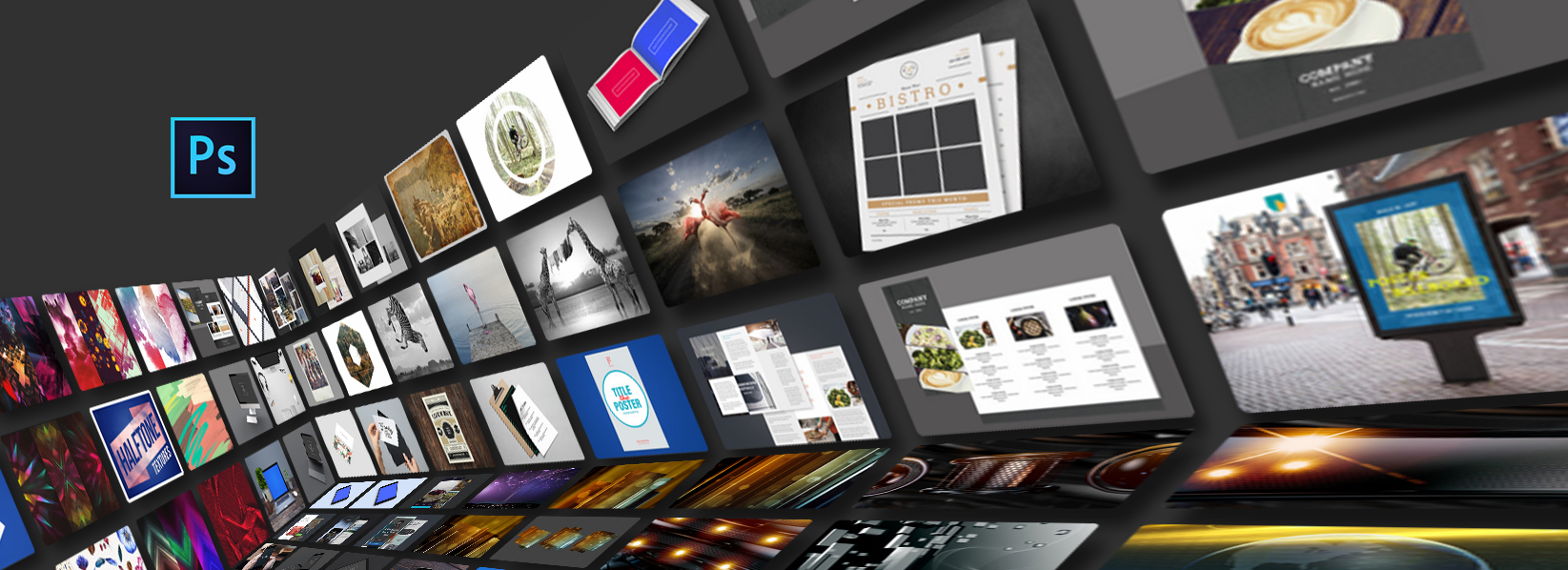

When you create a document in Photoshop, instead of beginning with a blank canvas, you can choose from a wide variety of templates from Adobe Stock. Templates include assets and illustrations that you can build on to complete your project. When you open a template in Photoshop, you can work with it just as you would work with any other Photoshop document (.psd).
In addition to templates, you can also create a document by selecting one of the numerous presets available in Photoshop or create your custom sizes. You can also save your own presets for reuse.
Templates and presets
Templates
provide inspiration and reusable elements for your documents. You can download templates from Adobe Stock that include quality graphics and illustrations right within Photoshop. You can then build on these templates to easily create documents that share common settings and design elements. Templates open as .psd files in Photoshop and generally include multiple artboards.
Blank Document Presets
are blank documents with predefined dimensions and settings. Presets make designing for specific device form factors or use cases easier. For example, you can use a preset to quickly start designing for the iPad Pro. Blank document presets have predefined size, color mode, unit, orientation, positioning, and resolution settings. You can modify these settings before creating a document using the preset.
Templates and presets are categorized into these sets:
- Photo
- Art & Illustration
- Web
- Mobile
- Film & Video
Access the New Document dialog
-
Launch Photoshop.
-
Do one of the following:
- Use the following keyboard shortcut:
- (Mac) Cmd+N
- (Windows) Ctrl+N
- Select File > New.
- Click New or Start New in the Start workspace.
- Right-click the tab for an open document and choose New Document from the in-context menu.


- Use the following keyboard shortcut:
Overview: New Document dialog
The New Document window lets you:
- Create documents using selected templates from Adobe Stock across several categories: Photo, Print, Art & Illustration, Web, Mobile, and Film & Video.
- Find more templates and create documents using them. See Search for more templates on Adobe Stock.
- Quickly access files, templates, and items that you've have recently accessed (Recents tab).
- Save your own custom presets for reuse and quickly access them later (Saved tab).
- Create documents using Blank Document Presets for multiple categories and device form factors. Before opening the presets, you can modify their settings.
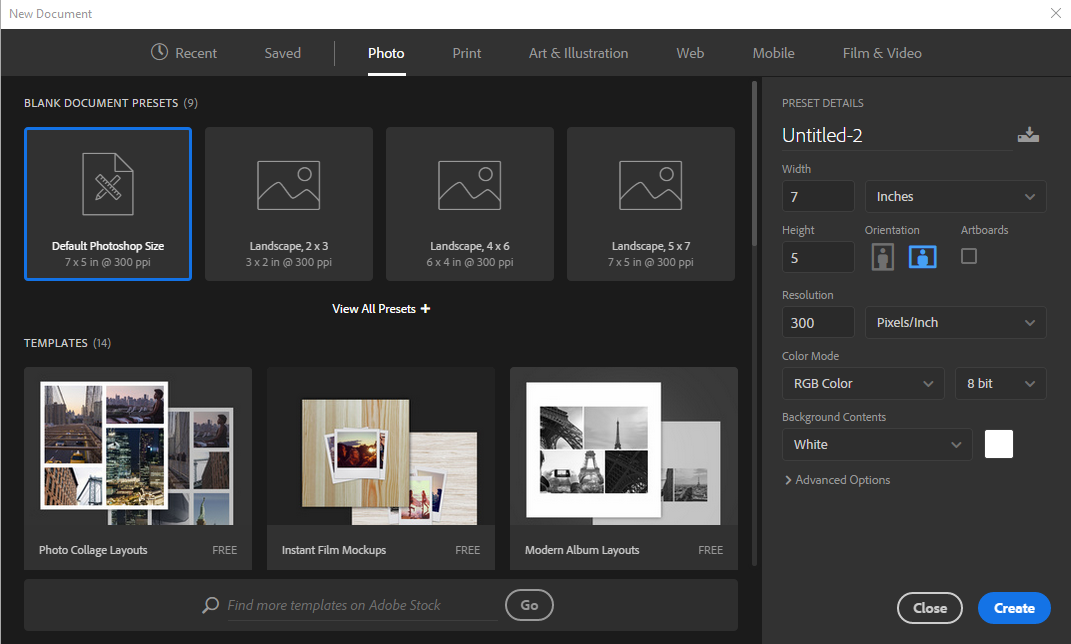

Create documents using presets
-
In the New Document dialog box, click a category tab: Photo, Print, Art & Illustration, Web, Mobile, and Film & Video.
-
Select a preset.
-
Optionally, change the settings for the selected preset in the Preset Details pane on the right. See Modify presets to understand how.
-
Click Create. Photoshop opens a new document based on the preset.
Modify presets
Before opening a document using the preset, you can modify its settings in the right pane.
-
Specify a file name for the new document.

The Preset Details pane 
The Preset Details pane -
Specify the following options for the selected preset:
Width and Height: Specify the size of the document. Select the unit from the pop-up menu.
Orientation: Specify a page orientation for the document: Landscape or Portrait.
Artboards: Select this option if you want your document to have artboards. Photoshop adds an artboard while creating the document.
Color Mode: Specify a color mode for the document. Changing the color mode converts the default contents of the selected new document profile to a new color.
Resolution: Specify the fineness of detail in a bitmap image measured in pixels/inch or pixels/centimetre.
Background contents: Specify a background color for the document.
-
To specify the following extra options, click Advanced Options.


Color Profile: Specify the color profile for your document from a wide range of options.
Pixel Aspect Ratio: Specify the ratio of width to height of a single pixel in a frame.
-
Click Create to open a document with the preset settings.
Save your own presets
The Preset Details pane lets you modify an existing preset or specify fresh settings for a new one. To save your custom settings as a new preset, follow these steps:
-
After you're done specifying the settings, click the
 icon in the Preset Details pane.
icon in the Preset Details pane. -
Specify a name for the new preset.
-
Click Save Preset.
You can later access the new preset from the Saved tab of the New Document dialog.
Create documents using templates from Stock
Photoshop comes with various templates from Adobe Stock. Templates with font layers use basic fonts or fonts that can be synced from Adobe Fonts. To create a document using a template, do one of the following:
-
In the New Document dialog, click a category tab: Photo, Print, Art & Illustration, Web, Mobile, and Film & Video.
-
Select a template.
-
Click See Preview to view a preview of the template. A preview is an image representation of a template that you can review and decide if you want to license that template.



Preview the template before licensing it 
Preview the template before licensing it -
Click Download.
Photoshop prompts you to license the template from Adobe Stock. See Adobe Stock Help for more information about licensing and related considerations. After the template has been licensed using asset entitlements or credits in your account, you can open it as a Photoshop document for you to work on.

Template licensing in progress 
Template licensing in progress -
After the template has downloaded, click Open. While opening the template, if you're prompted to sync some fonts from Typekit, click OK.
You can now work with the open document in Photoshop just as you would work with any other .psd document.
Notes:
- Downloaded templates are added to a Creative Cloud library called Stock Templates. You can access this library in the Libraries panel.
- Photoshop templates carry the .psdt filename extension. However, when you open a template, an instance of it is opened as a .psd document. Changes made to that .psd document don't affect the original .psdt template.
Search for more templates from Adobe Stock
Aside from the preselected templates from Adobe Stock, you can search for and download numerous other such templates directly from within the New Document dialog.
- While working in the New Document dialog, enter a search string in the Find More Templates On Adobe Stock box. Alternatively, simply click Go to browse the full selection of available templates.
Photoshop opens the Adobe Stock website in a new browser window for you to explore. Search for more templates and download the one that best meets your project's requirements.
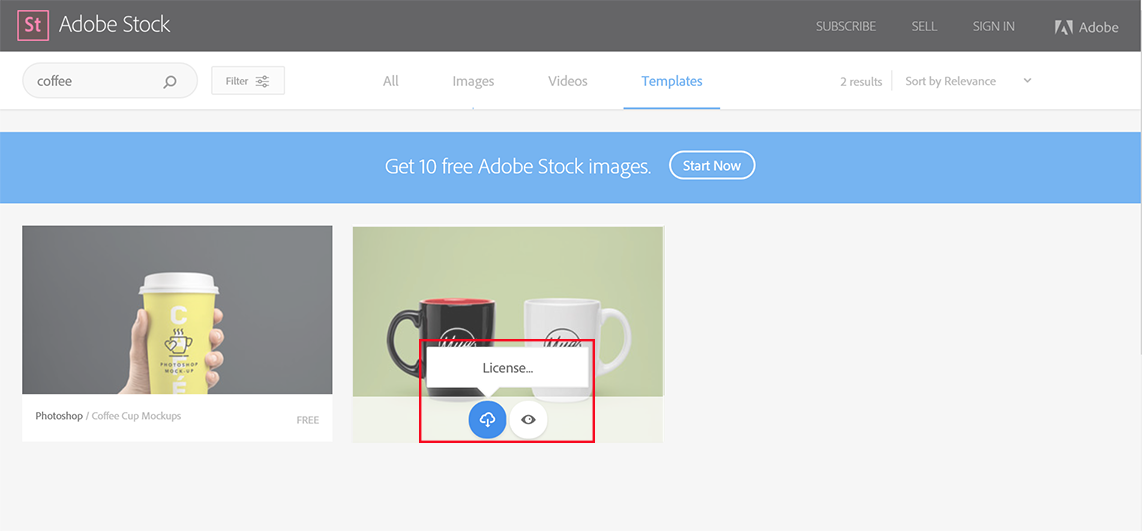

Use the legacy File New experience
Although not recommended, you can disable the latest New Document experience and revert to the File New experience that Photoshop provided by default (in versions 2015.5 and earlier).
-
Select Edit > Preferences > General.
-
Select Use Legacy File New Interface. Click OK.

Enable the legacy File New experience (not recommended) 
Enable the legacy File New experience (not recommended)
You can use the keyboard shortcuts for opening files (Ctrl/Cmd+O) or starting new documents (Ctrl/Cmd+N) to open this dialog box.
FAQ
Templates in Photoshop exist in the .psdt format. When you open a template, Photoshop creates an instance of it as a document. You can work on and save that document just as you would work with any other Photoshop document.
You can further customize a saved preset in the Preset Details pane. The new preset, however, must be saved with a different name.
No. Any changes you make to the template instance after downloading it aren't applied to the original template.
The templates that you download in Photoshop and Illustrator are found in Libraries. You can open only.psdt templates in Photoshop and only.ait templates in Illustrator.
